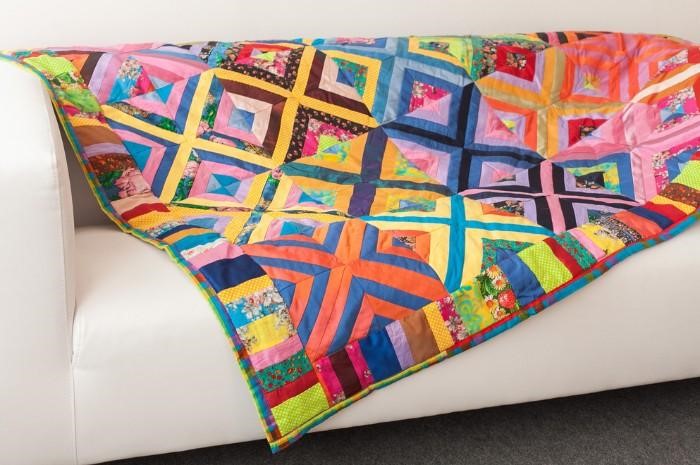
Subscribe To Emails
Subscribe to the YourCotton mailing list to receive updates on new arrivals and promotions (about once every 6 weeks)!

Are you looking to make a handcrafted blanket to brighten up your home? Quilting is a time-honored craft that can bring joy and tremendous satisfaction. Even if you're just getting started, with the right supplies and some essential quilting tips, you'll be ready to create something cozy and beautiful in no time! This article shows you five easy steps to make a fantastic quilt that keeps your family snug during winter nights. Keep reading to learn more about our simple yet effective approach to turning fabric pieces into heirlooms that will last for years!
To handmade quilt a blanket, you will need the following supplies:
You’ll need to select a main and accent fabric for your blanket. The type of fabric you choose will depend on the project and pattern you are using. How much fabric you need will depend on the size of your project.
This insulating material goes between your two layers of fabric to create warmth and softness in the finished product. Choose batting based on how thick or thin you want your finished blanket to be.
Thread comes in many colors and weights, so choose one that matches or contrasts with your chosen fabrics. First quilting projects should use heavier threads for easier stitching.
This tool helps cut straight lines with ease. It’s beneficial for cutting fabric into large pieces.
These tools help you measure, plan, and mark your fabric accurately before you cut it.
You’ll need a hot iron to press seams flat and a heat-resistant surface to protect your fabrics from scorching.
A sewing machine makes the process of quilting much faster and easier than hand stitching. Choose a durable machine that will handle heavy-duty fabrics with ease.
Use needles to stitch by hand if desired, or use safety pins to hold layers together while working on the project. All the layers should be securely pinned before you start quilting.
This tool is a must when it comes to undoing mistakes during quilting. For a baby quilt, seam rippers are especially helpful since they can easily remove any extra stitches that may have been sewn on.
You’ll need sharp scissors for trimming seams and cutting fabric when needed.
With all the necessary supplies, you’re ready to start your quilt! Have fun and enjoy the process as you create a one-of-a-kind blanket that will be cherished for years.
Quilt a blanket by gathering your supplies, choosing a quilt pattern, and piecing together the fabric. The quilting process differs depending on the project, but here is a step-by-step guide:
Choose the quilting fabric for the quilt top and batting appropriate for the type of quilt you are making. If this is your first time quilting, it is recommended to use cotton fabric or polyester batting.
Use a rotary cutter and ruler to cut out multiple 4-inch squares (or other shapes) from each quilting fabric chosen for the blanket. To further customize your design, consider using precut hexagons or triangles.
Place one piece of backing down on a flat surface, followed by the batting layer and the quilt top layer. Pin-baste them together using safety pins, ensuring that all three layers are evenly lined up and smooth. The backing fabric should extend beyond the quilt top.
Choose a free-motion or walking foot machine quilting method to secure the layers of fabric together. You can use a straight line or decorative patterns as desired – ensure that each stitch is kept even with the others and not too tight!
Once you’ve finished sewing all three layers together, trim off any excess fabric from around the edges so it fits your desired size. Finally, bind the edges with bias tape or mitered binding for a neat finish. Congratulations - you’ve made your very own quilted blanket!
Quilting stitches are types used to create a quilt top or add decorative detail to a finished quilt. Quilters use different types of stitches for various applications. Some of the most common quilting stitches include running stitch, cross stitching, free-motion quilting, stippling, and echo stitching.

This stitch type is one of the oldest forms of hand sewing and is still widely used in quilting and other crafts. It consists simply of an up-and-down stitch that is worked in even intervals on the fabric surface, often referred to as a “straight line” stitch pattern.
Cross stitching is an embroidery technique to create unique patterns and textures on quilts and other fabric projects. Using two strands of thread, the stitches are worked in a criss-cross pattern to produce a repeating design.
In this type of quilting stitch, the needle moves freely through the fabric with no prior markings or guiding lines. This method allows for greater creativity and freedom of expression when constructing quilts.
Stippling is a variant of free-motion quilting where small dots are regularly placed on the fabric's surface. This provides texture and visual interest to a finished quilt project.
Echo stitching is a type of quilting stitch typically used to create more intricate patterns, such as vines and flowers. In this technique, several rows of stitches are worked around a center line to create a pattern called an “echo.” This type of stitching can be done by hand or using a machine.
These are just some types of quilting stitches for use in quilt making. Quilters have long been experimenting with various techniques to enhance the look and feel of their projects, so the possibilities are endless.
Quilting a blanket is an enjoyable and creative process that will bring you the satisfaction of creating something unique and beautiful. With the right supplies and our five easy steps, you can quilt your cozy blanket in no time! Don’t forget to experiment with various quilting stitches for a more personalized design. Keep practicing and learning new techniques, and soon you will be able to call yourself a master quilter!